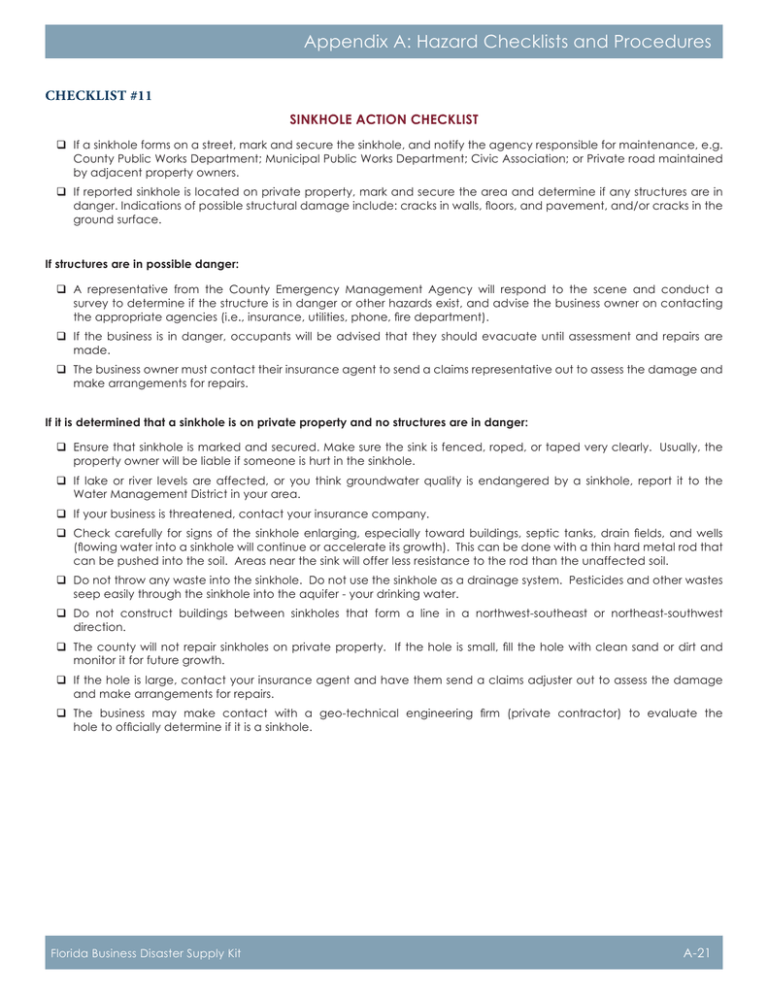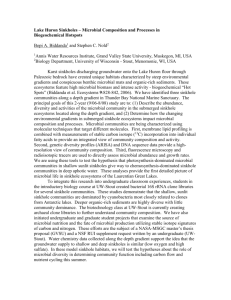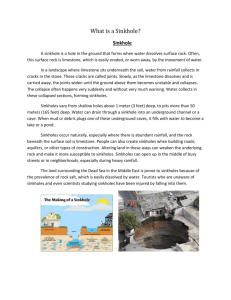Appendix A: Hazard Checklists and Procedures CheCklist #11 sinkHole aCtion CHeCklist
advertisement

Appendix A: Hazard Checklists and Procedures Checklist #11 Sinkhole Action Checklist If a sinkhole forms on a street, mark and secure the sinkhole, and notify the agency responsible for maintenance, e.g. County Public Works Department; Municipal Public Works Department; Civic Association; or Private road maintained by adjacent property owners. If reported sinkhole is located on private property, mark and secure the area and determine if any structures are in danger. Indications of possible structural damage include: cracks in walls, floors, and pavement, and/or cracks in the ground surface. If structures are in possible danger: A representative from the County Emergency Management Agency will respond to the scene and conduct a survey to determine if the structure is in danger or other hazards exist, and advise the business owner on contacting the appropriate agencies (i.e., insurance, utilities, phone, fire department). If the business is in danger, occupants will be advised that they should evacuate until assessment and repairs are made. The business owner must contact their insurance agent to send a claims representative out to assess the damage and make arrangements for repairs. If it is determined that a sinkhole is on private property and no structures are in danger: Ensure that sinkhole is marked and secured. Make sure the sink is fenced, roped, or taped very clearly. Usually, the property owner will be liable if someone is hurt in the sinkhole. If lake or river levels are affected, or you think groundwater quality is endangered by a sinkhole, report it to the Water Management District in your area. If your business is threatened, contact your insurance company. Check carefully for signs of the sinkhole enlarging, especially toward buildings, septic tanks, drain fields, and wells (flowing water into a sinkhole will continue or accelerate its growth). This can be done with a thin hard metal rod that can be pushed into the soil. Areas near the sink will offer less resistance to the rod than the unaffected soil. Do not throw any waste into the sinkhole. Do not use the sinkhole as a drainage system. Pesticides and other wastes seep easily through the sinkhole into the aquifer - your drinking water. Do not construct buildings between sinkholes that form a line in a northwest-southeast or northeast-southwest direction. The county will not repair sinkholes on private property. If the hole is small, fill the hole with clean sand or dirt and monitor it for future growth. If the hole is large, contact your insurance agent and have them send a claims adjuster out to assess the damage and make arrangements for repairs. The business may make contact with a geo-technical engineering firm (private contractor) to evaluate the hole to officially determine if it is a sinkhole. Florida Business Disaster Supply Kit A-21






